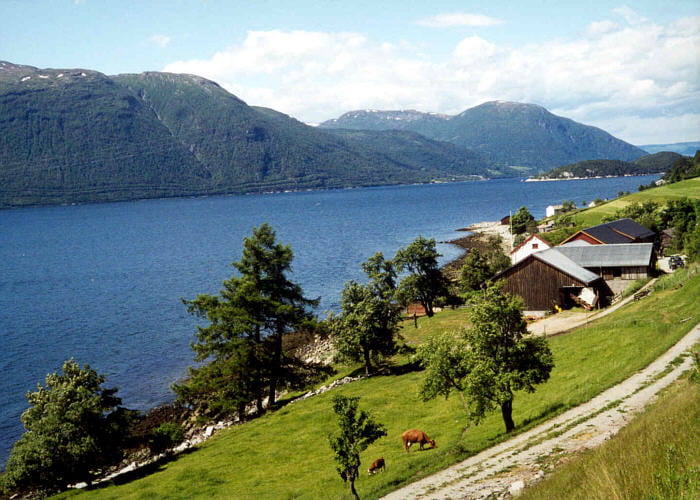This set of photos concentrates on eclogites and some medium pressure corona gabbros in the Caledonides of western Norway. Most of these rocks have broadly basaltic compositions, and were metamorphosed during different phases of the Paleozoic Caledonian Orogeny. The high pressure rocks were brought rapidly enough to the surface so that some eclogites scarcely have any evidence of retrograde metamorphism. This guided tour is more or less from Trondheim, wandering southwest to the Nordøyane islands and the nearby Brattvåg area, just off Moldefjord.

Simplified geologic map of Norway, Sweden, and Finland. The photos below are from Norway, from the Trondheim area and regions to the southwest. The blue line was another field trip and has nothing to do with the photos below.
This map isn’t mine. Sorry, but I’ve lost track of the source. If you know who made or published this, please tell me so I can properly cite it.

Ferry trip across a fjord.

Another lovely fjord.

Pillow lavas in Løkken. Notice that they are nearly upside-down. These have been metamorphosed to epidote-amphibolite facies.

Pillow lavas in Løkken, close-up of the rind of two adjacent pillows. The difference in appearance between the rind (dark) and pillow interiors (yellowish, left and right), is caused by pre-metamorphic chemical alteration of the glassy pillow surface.

Sulfide layer in hydrothermally altered, pyritic mafic rocks at Løkken.

Close-up of the sulfides in the sulfide layer in the photo immediately above.

View of the coast of the island of Lepsøy.

Layers of middle Proterozoic gneiss and late Proterozoic amphibolite, Lepsøy.

Amphibolite boudins in middle Proterozoic gneisses, Lepsøy.

Amphibolite and middle Proterozoic gneisses, Lepsøy.

Amphibolite layers in quartzite, with some of the amphibolites having developed ‘bookshelf’ or ‘domino’ boudins. Somewhere on the south shore of Moldefjord.

View from Haramsøy to Lepsøy.

Field with eclogite boudins bumping up all over the place.

Eclogite boudins, bumping up in the field.

Retrograded eclogite. The red things are garnets, green is augite-plagioclase symplectite, and black is hornblende. This is typical of this eclogite frield, quite a mess.

Retrograded eclogite, showing off lichen.

Layered cumulate section in a corona gabbro (Haram Gabbro).

Close-up of the Haram corona textures in the corona gabbro.

Pyroxene-plagioclase pegmatite body in the Haram corona gabbro

Retrograded eclogite. The green symplectites are rather dull and grayish, compared to fresh omphacite.

Fresh orthopyroxene- and omphacite-bearing eclogite.

Eclogite boudin on the north shore of Flemsøy.

Fresh kyanite eclogite in the boudin shown above.

Another fresh kyanite eclogite.

Partially retrograded kyanite eclogite.

Kyanite-garnet gneiss (reportedly containing rare microdiamonds, which attracted Barbie).
